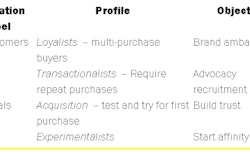
In my article from the Green Industry Pros March 2020 issue, entitled, “The Grass Gets Greener When You Know Its Size,” I likened a retailer’s customer base to a field of crops: In order to reap sustained harvest in the form of revenue, retailers must cultivate that field to be as healthy as possible. Given this, we are posed with a natural next question: What exactly does a healthy field look like?
To begin answering that question, I’ll move from the farm to the hen house for the classic adage: Don’t put all your eggs in one basket.
Any judicious mother or investment strategist might impart these wise words. The message is simple: Concentrating all your resources or efforts into a single plan or strategy can be dangerous due to increased exposure to risk. With one bad jolt, a seemingly-robust plan suddenly appears quite lopsided and fragile.
Business strategy is no different – and particularly so in the world of retail. While focusing on sustaining a core customer base is certainly advantageous in the near term, prudent managers must ask themselves how long the gravy train will last. If that core base is subject to sudden shock, like outside economic forces (say, a recession, or a large local unemployment event), increased supply from your competitors, or simply the natural timing-out of the customer life cycle (say, your core base already bought your full offering, or ages out of products based on use case), you might find yourself in a scramble.
To avoid those chickens coming home to roost, it therefore seems imperative that, before focusing on each individual customer’s health, retailers first assess the health of their customer reach. How wide is this field? What variety of crops grow in it? And, given the answers to these questions, how can we go about expanding the size and composition of that reach?
This line of thought brings us to customer breadth, an important prerequisite to a healthy customer base. Having a broad base of customers – both in terms of volume as well as type – helps your business grow in sales while also protecting against risk and ensuring long-term success. In this article, we’ll explore some important metrics to look at in order to assess customer breadth, and tactics one might take in order to enhance it.
A Breadth of Metrics
Customer breadth, defined broadly, is how many customers you have across area and segment. In order to measure the extent of that reach, as well as understand its changes day-to-day, retailers must establish some definitions, key groups and breakdowns, and metrics to track.
To begin, let’s define “customer.” This might seem obvious at first: A “customer” is someone who’s bought something from you. Sounds great – but what about a customer who bought something 10 years ago, and hasn’t bought since? This brings to bear the notion of active customers, who are still making purchases and showing engagement with you, versus dormant customers, who made their last purchase long enough ago such that they should have come back by now. While the exact time window will vary based on anticipated product life cycle (for instance, about 5-7 years for consumer handheld power equipment), once that dormancy period has elapsed, we can assume they’ve either exited the market (perhaps they moved away, or aged out), or they’ve gone to your competitor. Either way, those dormant customers are effectively lost, so retailers should establish a dormancy window that makes sense for their business, draw a line in the sand – turf – and only incorporate active customers into their assessment of customer reach.
Next, in order to make customer insights actionable, we’ll want to consider breakdowns for analyzing customer breadth. This brings us to customer segmentation, where we splice and dice those active customer records by area – such as state, county, MSA (Metropolitan Statistical Area), city, or ZIP code – and demographic – such as age, gender, occupation, homeowner status, and other social attributes. For commercial customers, breakdowns might also include industry, size of company, and time in operation. The nature of your breakdowns really comes down to what’s available in your customer and purchase data, but as a rule of thumb, the more, the better, since customers with similar traits often exhibit similar purchasing patterns. Good sources of information might include your POS (Point-of-Sale) or CRM (Customer Relationship Management) systems.
Finally, we arrive at the metrics to calculate. For the purposes of assessing Customer Breath, we’re mainly concerned with counting the customers themselves – regardless of purchase volume or value.
A few important metrics are as follows, all of which should apply towards active customers across each of the segments and breakdowns you’ve been able to muster:
- Unique Active Customer Count: A seemingly simple metric, obtaining a unique customer count can be tricky depending on the nature and quality of your data, since customer names and addresses must be de-duplicated while accounting for syntax and spelling variations. “Bob Smith” at “123 Country Lane” and “Robert Smith” at “123 Country Ln.” may very well be the same customer, but your software won’t know that unless you tell it so. For manually-entered data, typos present a challenge as well. Nonetheless, once determined, this important metric can be tracked over time and segment to understand, point blank, how big your active customer base is, and whether it’s been growing or shrinking.
- Market Penetration: Also seemingly simple, market penetration aims to tell you the percentage of a given market that you have as active customers. This is comparative, to help understand how much room you have to grow. Your unique active customer count might be growing 10% in the county over, for instance, but only account for 1.5% penetration in that county. The trick here is determining market size. This will depend on the nature of your business and products, though the large distinction will likely come down to consumer vs. commercial markets. For the former, you might consider looking to the Census for a count of homeowners living in Single-Unit Dwellings (SDU’s) by area. For the latter, reports from industry member organizations – such as the National Association of Landscape Professionals (NALP) in the OPE world – might shed some light, as well as market research studies.
- % New/Repeat Customers: The net-new vs.. repeat customer ratio checks whether a given customer has ever made a prior purchase – back to the beginning of time, regardless of dormancy window. This matters immensely, since, even though the marketing team should treat a dormant customer similarly to prospects, reclaiming a dormant customer is more like playing catch-up, and does not broaden your brand. To use our field analogy, a reclaimed dormant customer is like a withered crop that you started watering again; a net-new customer, on the other hand, is a new sapling in the ground. Understanding the net-new customer ratio per area or segment helps you understand where you’re gaining traction. For multi-location retailers as well as distributors, calculating net-new customers by retail location can be fruitful as well. In this case, you’d check if a “new” customer has ever bought from your organization before, in addition to making a first purchase at a given rooftop. This illuminates the true broadening of your base – as opposed to “cannibalization,” where existing customers simply start shopping at a new location.
- Unique Customers: Finally, retailers can greatly benefit by tracking if a given unique customer has purchased at least one of a given product or product type – as opposed to simply making a transaction in general. This metric can be used to further derive product penetration – market penetration for a specific item or item group – but for the purposes of expanding unique customer breadth in total. Its greatest use is finding correlations to identify driving forces and areas of opportunity to aid marketing in new customer acquisition.
Planting Season
Once customer breadth is defined and calculated, it’s time to go out and test that green thumb to bring new customers into the fold. Avenues for doing so abound, from email marketing and promotional events (dog-friendly cornhole Saturdays to court millennials, perhaps?) to social media and traditional channels like print or radio. Many other blogs and articles are devoted to marketing channels and how to go about them, so I’ll defer to those for now in terms of tactics.
In terms of strategy, though, two major postures are worth noting: Going with the flow and filling the gaps.
If something’s already working, even on a small scale, why not lean into it? Going with the flow, or following demand, allows marketers to capitalize on preexisting trends – if they only know where to look. Finding stand-out customer groups with spikes in product adoption can be key here to provide insight for targeted marketing campaigns towards new prospects. Questions to ask include:
Among net-new customers over the last 12 months, which product has the highest adoption (that is, the highest unique customer count)?
Among a segment of interest (say, millennial homeowners), which product has the highest adoption?
Which customer segment has the largest spike in product adoption (for any product or type), and in what ZIP is the penetration for that segment lowest?
The answers to these questions could lead to focused marketing campaigns, leveraging the knowledge that a given product is correlated with bringing new customers into the fold, or with a customer type you may want to court. From there, armed with this highly-adopted product of interest, one might look at where penetration for the target segment is lowest, and target an email or flyer campaign.
The second strategic posture is filling in gaps – that is, addressing those customer holes large enough where sales and adoption data might be lacking. Rather than methodically marketing specific products to specific customer segments, gap-filling falls more under generic marketing to increase awareness of your brand or product use case. A question to ask here might be: Which customer segment has the lowest penetration overall? Or perhaps, which county has had a declining net-new acquisition rate over the last two years?
These areas in need of love might need some blanket-marketing tactics, like print, radio, social media posts, or blog content angled towards those groups to drive awareness. Opening a new location, or perhaps even a seasonal pop-up location, can be a worthwhile investment as well. Beyond any actual net-new customers you may pick up from dropping an outpost in the middle of a customer desert, you’ll likely gain in marketing and awareness from folks driving by and word of mouth. At the very least, for those tough customer groups who just aren’t within your reach yet, understanding any market size information, as gleaned from the census and other public information, is certainly helpful to make sure you’re aiming at the largest prospect pools possible.
Fertile Pastures
In all, sustained revenue requires a healthy customer base, and the health of that customer base depends on its size and variety – that is, having a broad base of demand across people and places to insulate against the wear and tear of customer churn. Though it may necessitate some number-crunching at the outset, setting clear definitions and measurements can help retailers understand their current customer spread, and enhance it either by leaning into customer adoption trends, or filling in the gaps through informed brand marketing.
Once a healthy reach is achieved, retailers can move on to nurturing and cultivating each customer in terms of customer depth: increasing engagement and loyalty where, hopefully, they bear fruit again and again. We’ll discuss this cultivation step in subsequent “Grass Gets Greener” segments. For now, by distributing those eggs across more and more baskets and focusing on customer breadth, you’ll be feeling sunny-side up.


![Doosan Bobcat Wacker Neuson Stack 2ec Js Pb V6e[1]](https://img.greenindustrypros.com/mindful/acbm/workspaces/default/uploads/2025/12/doosan-bobcat-wacker-neuson-stack2ecjspbv6e1.CPyyz8ubHn.png?auto=format%2Ccompress&bg=fff&fill-color=fff&fit=fill&h=100&q=70&w=100)








![Doosan Bobcat Wacker Neuson Stack 2ec Js Pb V6e[1]](https://img.greenindustrypros.com/mindful/acbm/workspaces/default/uploads/2025/12/doosan-bobcat-wacker-neuson-stack2ecjspbv6e1.CPyyz8ubHn.png?ar=16%3A9&auto=format%2Ccompress&bg=fff&fill-color=fff&fit=fill&h=135&q=70&w=240)








